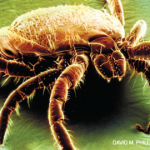‘I think Lyme disease is going to come up in your practice no matter where you are practicing.’ —Robert A. Kalish, MD
Leprosy
Vikas Agarwal, MD, professor at the Sanjay Gandhi Postgraduate Institute of Medical Sciences, India, took the stage to speak about leprosy and other mycobacterial arthritis. He explained that Mycobacterium leprae causes a chronic granulomatous disease associated with leprosy, and emphasized that leprosy is not just limited to endemic zones, but can appear in areas supposedly free of leprosy—it has even been reported in Louisiana. Dr. Agarwal explained that suspicion is key for early diagnosis of leprosy, and the clinical features of arthritis can be easily identified by careful evaluation of these patients.
Leprosy has a classic presentation in the skin that includes macules, plaques and papules/nodules. Patients may also suffer swollen hand and foot syndrome with acute onset symmetric polyarthritis. One important clue for diagnosing mycobacterial arthritis is the presence of swollen hand and feet syndrome with painful diffuse pitting edema and nodules along the tendons.
Another potentially useful way of distinguishing between RA and mycobacterial arthritis is anti-cyclic citrullinated peptide (anti-CCP) antibody testing, which is more likely to be positive in patients with RA than in patients with mycobacterial arthritis.
Dr. Agarwal concluded his presentation by stating that the mainstay treatment for mycobacterial arthritis is anti-tuberculosis drug therapy, which should run for 12–18 months.
Lyme Disease
Robert A. Kalish, MD, director of rheumatology education at Tufts Medical Center in Boston, gave a presentation on Lyme disease, noting, “I think Lyme disease is going to come up in your practice no matter where you are practicing.”
He explained that Lyme disease includes Lyme arthritis, post-Lyme syndrome and chronic Lyme disease. It is transmitted by a bite from an adult deer tick, which is approximately the size of a sesame seed. He emphasized that these ticks are spreading throughout the U.S. In some cases, patients may not have only Lyme disease, but also co-infections and autoimmune syndromes that follow infection. Dr. Kalish reminded the audience to consider other infections that could be transmitted via deer tick, including emerging viral infections.
Lyme disease presents with a classic bullseye on the skin, followed by secondary lesions that are flat. It is diagnosed by serologic testing; although some physicians use IgM antibodies, IgG seems to be a more reliable and specific marker, because IgM antibodies appear two to four weeks post-infection and peak at three to six weeks post-infection, disappearing by six months.
Healthcare providers should treat patients with early localized and disseminated infection with 10–21 days of oral antimicrobial therapy (i.e., doxycycline, amoxicillin and cefuroxime axetil). A 14-day course of oral doxycycline is recommended for treatment of early neurologic Lyme disease in ambulatory patients, and a four-week course is recommended for patients with arthritis. Patients who are highly immunocompromised may require a minimum of six weeks of antibiotics.



